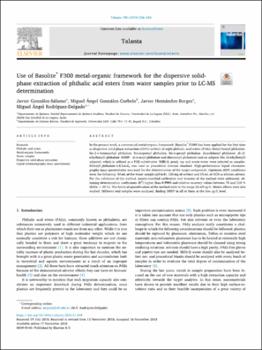Use of Basolite® F300 metal-organic framework for the dispersive solid-phase extraction of phthalic acid esters from water samples prior to LC-MS determination
Fecha
2018Resumen
In the present work, a commercial metal- organic framework (Basolite®F300) has been applied for the first time as dispersive solid-phase extraction (dSPE) sorbent of eight phthalic acid esters (PAEs) (butyl benzyl phthalate, bis-2-n-butoxyethyl phthalate, bis-isopentyl phthalate, bis-n-pentyl phthalate, dicyclohexyl phthalate, di-(2ethylhexyl) phthalate-DEHP-,di-n-octyl phthalate and diisononyl phthalate) and anadipate (bis(2-ethylhexyl) adipate), which is utilized as a PAE substitutive. Milli-Q, pond, tap and waste wáter were selected as samples. Dihexyl phthalate-3,4,5,6-d4 was used as procedural internal standard. High-performance liquid chromatography mass spectrometry was used for the determination of the target compounds. Optimumd SPE conditions were the following: 50mL of the water sample (pH6.0), 120mg of sorbent and 15mL of ACN as elution solvent. For the validation of the method, matrix-matched calibration and trueness of the method were addressed, obtaining determination coefficients (R2) higher than 0.9905 and relative recovery values between 70 and 118% (RSDs < 20%). The limits of quantification of the method were in the range 22–69ng/L. Matrix effects were also studied. Different real samples were analysed, finding DEHP in all of them at the low µg/L level.





